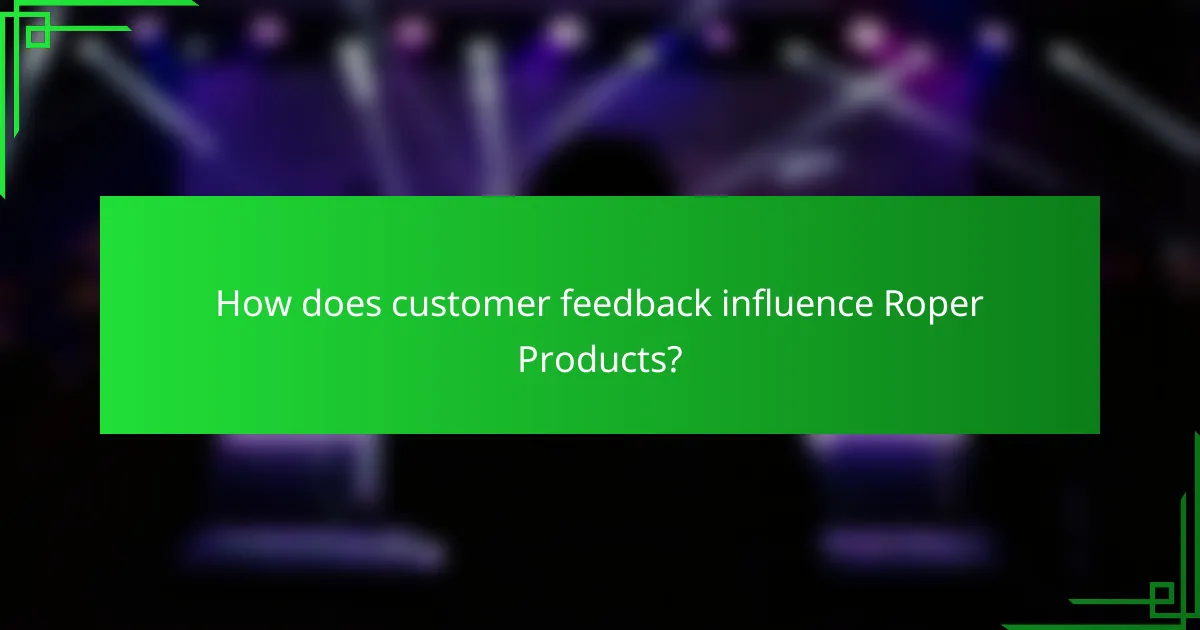Roper Products prioritizes user-centric design by engaging users throughout the development process, ensuring that their products align with real needs and preferences. This structured approach incorporates collaboration, prototyping, and testing, allowing for continuous refinement. Additionally, customer feedback is integral to Roper’s innovation strategy, enabling the company to identify improvement areas and enhance overall user satisfaction.

How does Roper Products prioritize user-centric design?
Roper Products emphasizes user-centric design by actively involving users throughout the development process. This approach ensures that products meet real needs and preferences, ultimately enhancing user satisfaction and usability.
User feedback integration
User feedback integration is a cornerstone of Roper Products’ design philosophy. The company collects insights through surveys, interviews, and focus groups, allowing them to understand user experiences and expectations. This feedback is systematically analyzed and directly influences design decisions.
Regularly engaging with users helps Roper Products identify pain points and areas for improvement, ensuring that the final product aligns with user needs. For instance, if users express difficulty in navigating a product feature, the design team can prioritize adjustments based on that input.
Usability testing methods
Roper Products employs various usability testing methods to evaluate product effectiveness before launch. These methods include remote testing, in-person sessions, and A/B testing, which allow the team to observe how real users interact with their products in different environments.
During usability tests, participants are asked to complete specific tasks while observers note any challenges faced. This direct observation helps identify usability issues that may not be apparent through surveys alone, leading to more informed design refinements.
Design iteration process
The design iteration process at Roper Products is agile and responsive, allowing for continuous improvement based on user feedback and testing results. Each iteration involves revisiting design concepts, prototyping, and testing, ensuring that the product evolves to better meet user needs.
Typically, multiple cycles of design and testing occur, with each cycle lasting a few weeks. This iterative approach not only enhances product quality but also fosters a culture of innovation, where user insights drive ongoing enhancements and adaptations.

What is the development process for Roper Products?
The development process for Roper Products focuses on user-centric design, ensuring that products meet customer needs through a structured approach. This process includes several key stages that involve collaboration, prototyping, and testing to refine the final product.
Stages of product development
The stages of product development at Roper Products typically begin with idea generation, where concepts are brainstormed based on market research and user feedback. This is followed by feasibility analysis to determine the practicality of the ideas, including cost estimates and resource allocation.
Next, the design phase involves creating detailed specifications and initial designs. This is crucial for aligning the product vision with user expectations. After design, the development phase focuses on building the product, incorporating any necessary adjustments based on initial feedback.
Collaboration with designers
Collaboration with designers is integral to Roper Products’ development process. Designers work closely with engineers and product managers to ensure that the aesthetic and functional aspects of the product align with user needs. Regular meetings and brainstorming sessions foster an environment where ideas can be shared and refined.
Utilizing design thinking principles, the team emphasizes empathy for users, which helps in creating solutions that are not only innovative but also practical. This collaborative approach often leads to better problem-solving and more effective product outcomes.
Prototyping and testing
Prototyping and testing are critical components of the development process at Roper Products. Initial prototypes are created to visualize concepts and assess functionality. These prototypes undergo rigorous testing to identify any design flaws or usability issues before final production.
User testing is particularly important, as it provides direct feedback from the target audience. This feedback helps in making necessary adjustments, ensuring that the final product meets quality standards and user expectations. Iterative testing allows for continuous improvement, ultimately leading to a more successful product launch.

How does customer feedback influence Roper Products?
Customer feedback plays a crucial role in shaping Roper Products’ design and development processes. By actively listening to users, Roper can identify areas for improvement and innovate effectively to meet customer needs.
Feedback collection methods
Roper Products employs various methods to gather customer feedback, including surveys, focus groups, and direct interviews. These approaches allow the company to collect qualitative and quantitative data, ensuring a comprehensive understanding of user experiences.
Additionally, Roper utilizes online platforms and social media to engage with customers, encouraging them to share their thoughts and suggestions. This multi-channel strategy helps capture a diverse range of opinions and insights.
Impact on product improvements
Customer feedback directly influences product enhancements at Roper Products. Insights gathered from users often lead to modifications in design, functionality, and usability, ensuring that products align with customer expectations.
For instance, if multiple users report difficulties with a specific feature, Roper prioritizes addressing these concerns in future updates. This iterative process fosters a user-centric approach, enhancing overall satisfaction and loyalty.
Case studies of customer suggestions
One notable case involved a suggestion from customers regarding the ergonomics of a popular kitchen appliance. After analyzing feedback, Roper redesigned the handle for improved comfort, resulting in a significant increase in positive reviews.
Another example is the introduction of a new color option for a product line based on customer requests. This change not only boosted sales but also demonstrated Roper’s commitment to listening and adapting to consumer preferences.

What are the key features of Roper Products?
Roper Products are distinguished by their user-centric design, innovative technology, and commitment to durability. These features ensure that the products not only meet customer needs but also enhance usability and longevity.
Innovative technology
Roper Products leverage cutting-edge technology to enhance functionality and user experience. Features such as smart connectivity and automated systems are integrated into many products, allowing for seamless operation and increased efficiency.
For example, some Roper appliances include energy-saving modes that adjust performance based on usage patterns, which can lead to significant savings on utility bills. This technology not only improves user convenience but also supports sustainability efforts.
Durability and reliability
Durability is a hallmark of Roper Products, designed to withstand the rigors of daily use. The materials used in manufacturing are selected for their strength and resistance to wear, ensuring that products maintain their performance over time.
Customers can expect Roper Products to last for many years, often backed by warranties that reflect the brand’s confidence in its reliability. Regular maintenance and proper usage can further extend the lifespan of these products, making them a wise investment.
Design aesthetics
The design of Roper Products balances functionality with visual appeal. Each product is crafted to fit seamlessly into modern homes, often featuring sleek lines and contemporary finishes that enhance any interior décor.
Moreover, Roper Products are available in various styles and colors, allowing customers to choose options that best suit their personal taste and home environment. This attention to design ensures that users do not have to compromise aesthetics for performance.

What are the benefits of Roper Products for consumers?
Roper Products offer several advantages for consumers, focusing on user-centric design, quality, and affordability. These benefits enhance the overall experience, ensuring that customers receive value and satisfaction from their purchases.
Enhanced user experience
Roper Products prioritize user experience through thoughtful design and functionality. Features such as intuitive controls and ergonomic shapes make their products easy to use, catering to a wide range of consumers.
For example, appliances designed with user feedback often include simplified interfaces that reduce the learning curve, allowing users to operate them efficiently from the start. This focus on usability leads to a more enjoyable interaction with the product.
Value for money
Consumers find Roper Products to be a great value for money due to their competitive pricing and reliable performance. The brand aims to provide high-quality items without the premium price tag, making them accessible to a broader audience.
When comparing similar products in the market, Roper often offers features and durability that rival higher-priced competitors. This balance of cost and quality ensures that customers feel they are making a wise investment.
Long-term customer satisfaction
Long-term customer satisfaction is a key benefit of choosing Roper Products, as they are built to last and backed by solid warranties. Consumers can expect reliable performance over time, which reduces the need for frequent replacements.
Additionally, Roper actively seeks customer feedback to improve future products, demonstrating their commitment to meeting consumer needs. This ongoing relationship fosters loyalty, as customers feel valued and heard in the development process.
